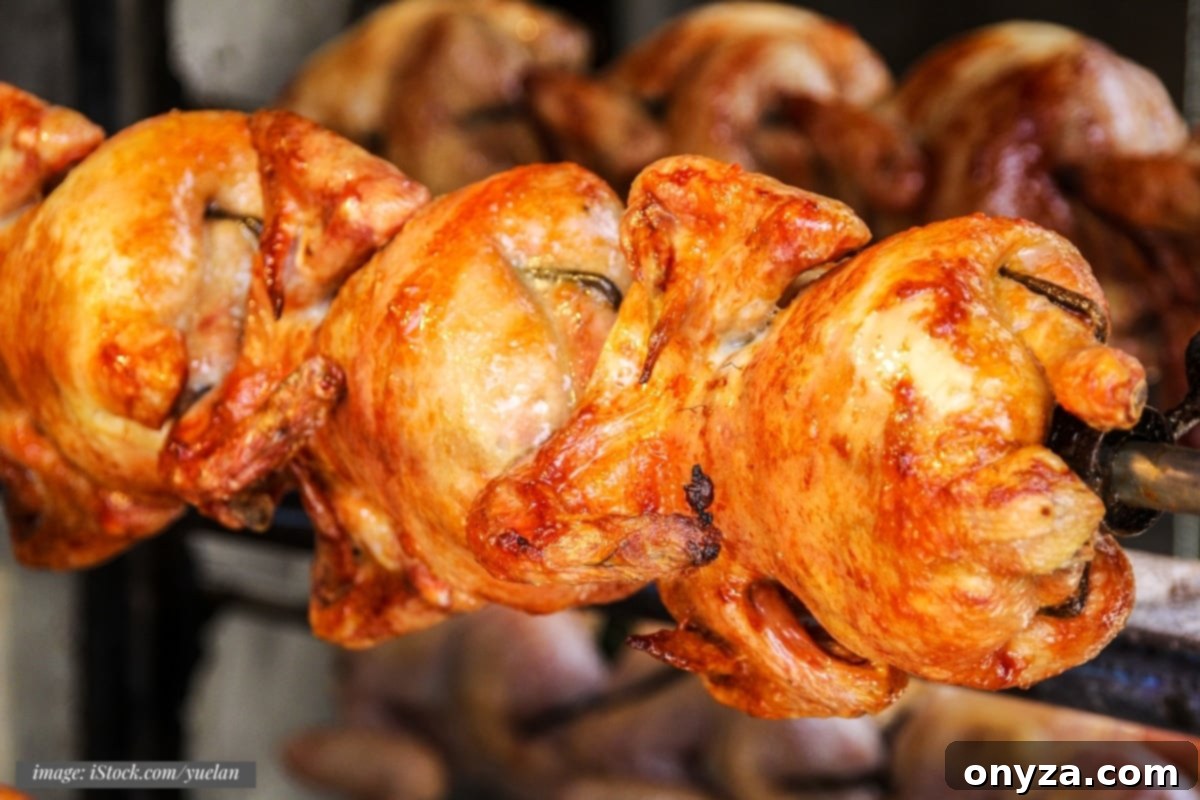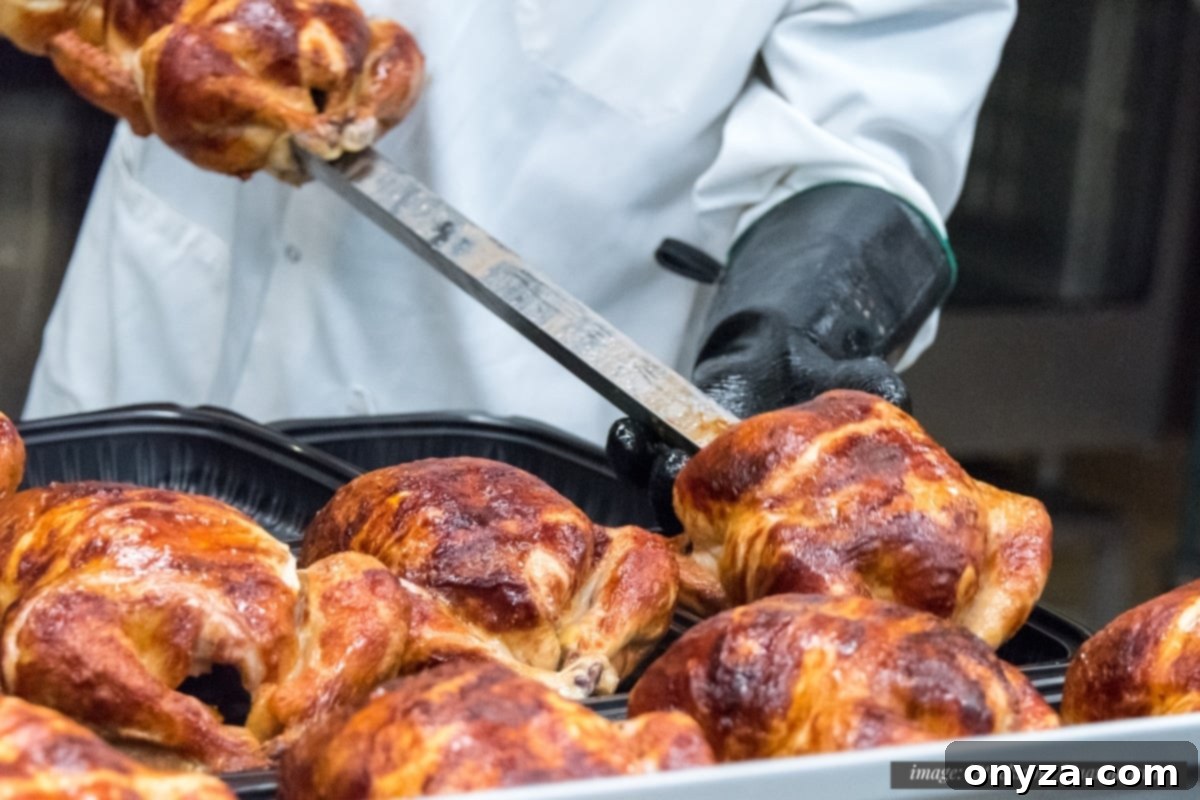Transform your weeknight meals by learning how to select the best rotisserie chicken from your grocery store. This comprehensive guide will ensure you never bring home a dry, disappointing bird again, guaranteeing a juicy and flavorful centerpiece for your dinner table!

This post contains affiliate links. As an Amazon Associate, I earn a commission (at no additional cost to you) from qualifying purchases made by clicking these links. As always, all recommendations and opinions expressed are my own.
In this Post:
- The Ultimate Grocery Store Rotisserie Chicken Guide
- Flavor Options: Plain vs. Seasoned
- Timing Is Everything: Fresh Off the Rotisserie
- Selecting from the Heated Display Case
- Beyond the Purchase: Maximizing Your Rotisserie Chicken Experience
- Delicious Rotisserie Chicken Recipes
The Ultimate Grocery Store Rotisserie Chicken Guide
In our fast-paced lives, the grocery store rotisserie chicken has become a true culinary hero. It’s more than just a convenient meal; it’s a versatile ingredient, a weeknight savior, and a budget-friendly option for busy families. Whether you’re grabbing one from a bustling warehouse club like Costco, which sells upwards of 60 million a year, or your local supermarket or farm market, its appeal is universal.
A perfectly cooked rotisserie chicken offers a delicious solution for dinner in a pinch or a fantastic head start for more complex recipes. Imagine skipping the raw chicken prep for dishes like comforting pot pies, cheesy enchiladas, hearty casseroles, or vibrant salads. It significantly cuts down on cooking time, making healthy, home-cooked meals more accessible.
While this guide focuses on mastering the art of buying the best rotisserie chicken, nothing quite compares to the crisp, buttery skin and succulent meat of a homemade roasted chicken. For a consistently perfect bird, every time, be sure to try my favorite Roasted Chicken recipe.
However, the convenience of a rotisserie chicken can sometimes come with a catch. We’ve all encountered those unfortunate birds—dry, bland, rubbery, or excessively greasy—that leave us feeling utterly disappointed. These less-than-ideal chickens often fall far short of the “well-prepared” mark, making the experience anything but satisfying.
During a recent discussion on Instagram about Costco grocery staples, many readers highlighted the rotisserie chicken as an absolute must-buy. When I casually mentioned my own “methods” for selecting the juiciest birds, my inbox was flooded with requests for these insider tips. Phrases like “I NEED TO KNOW your secrets!” and “Tell me how to pick a bird that isn’t dry!” echoed the collective frustration and desire for a better rotisserie chicken experience.
So, by popular demand, I’ve compiled this comprehensive guide to share my tried-and-true techniques. While some tips might seem like common sense, you might just discover a new trick or two that elevates your chicken-picking game. Let’s dive into the art and science of choosing the best rotisserie chicken!

Flavor Options: Plain vs. Seasoned
When it comes to rotisserie chicken, I almost always gravitate towards the **plain, unseasoned variety**. While some stores master their flavored chickens—think delightful Lemon-Garlic or smoky BBQ options—many tend to overdo it. You often find them either excessively salty or assertively flavored with artificial notes that overpower the natural taste of the chicken. This can be especially true for robust spice blends or sugary glazes.
Opting for a simply seasoned chicken, or one with minimal flavoring, offers far greater versatility. A plain bird acts as a blank canvas, allowing you to incorporate its meat into a wider array of dishes, from Asian-inspired stir-fries to Mexican tacos, or classic American comfort food, without conflicting flavor profiles. You can always add your preferred seasonings and sauces at home to match your meal.
It’s also crucial to consider the sodium content, especially if it’s a concern for your family’s health. Many rotisserie chickens, even the “plain” ones, are injected with a brining solution. This solution helps to keep the meat juicy and tender during the long roasting process, but it significantly increases the sodium levels. To mitigate this, look for organic or “all-natural” rotisserie chickens, and make it a habit to carefully read the nutrition facts and ingredients labels. These often contain fewer additives and lower sodium counts, offering a healthier choice without sacrificing flavor or juiciness.
Timing Is Everything: Fresh Off the Rotisserie
This tip is a true game-changer: if you can snag a chicken directly off the rotisserie spit, still glistening and hot, you are truly in for a treat. This is the **golden standard** for a juicy and flavorful rotisserie chicken. Most grocery stores roast their chickens in a visible area, making it surprisingly easy to peek at the timer or observe the staff at work. These birds are at their absolute peak, having retained maximum moisture and boasting perfectly crispy skin.
In the past, I used to try to discreetly monitor the rotisserie, perhaps from behind my sunglasses, to gauge when the next batch would emerge. However, I’ve learned that subtlety isn’t necessary. The deli or prepared foods staff are usually quite helpful and accustomed to customers inquiring about fresh chickens. Don’t hesitate to ask when the next batch will be ready; they often appreciate your interest in getting the best product.
Once you have an idea of the cooking schedule, you can strategically plan your shopping trip. The goal is simple: your rotisserie chicken should be **the very last item to go into your cart** before you head to checkout. Avoid letting it sit in your cart for an extended tour around the store, as this allows it to cool down and lose valuable moisture and crispness. A quickly cooling chicken starts to reabsorb its own steam, turning crispy skin into something far less appealing.
When the chickens are ready, don’t be shy. Politely ask an employee if you can have one of the chickens currently being taken off the spit or freshly boxed. In my experience, no one has ever refused, even if there are older chickens already sitting in the warming tray. It’s a simple request that makes a world of difference in the quality of your dinner.

After acquiring your freshest-possible chicken, make a direct beeline for the checkout. To preserve its warmth and juiciness on the journey home, I highly recommend bringing the bird home in an **insulated bag**. These bags are fantastic for maintaining temperature, whether hot or cold, and prevent rapid heat loss that can dry out your chicken. (Options like this Insulated Cooler Bag {affiliate link} are incredibly versatile and can hold a substantial amount of groceries.)
Does your grocery store operate with a closed kitchen, meaning the rotisserie isn’t visible? Don’t fret! Simply approach an employee in the deli or prepared foods department and ask when the next batch of rotisserie chickens will be ready. They are usually happy to provide this information, helping you time your purchase perfectly for optimal freshness.
Selecting from the Heated Display Case
While getting a chicken straight off the rotisserie is ideal, it’s not always feasible. More often than not, you’ll find yourself choosing from chickens that have been resting under a heat lamp or in a heated display case, typically housed in domed plastic containers. The challenge here is that the longer a chicken sits in these warming environments, the more susceptible it becomes to drying out, losing its moisture, and compromising its texture. However, with a keen eye and a few strategic checks, you can still identify the juiciest birds in the bunch.
1. Look for a Timestamp: Your Freshest Clue
Many responsible grocery stores will stamp the package with the exact time the chicken finished cooking. This timestamp is primarily for food safety regulations, indicating when the chicken must be pulled from the warmer (typically within a 2-4 hour window, depending on store policy). This information is your secret weapon! Use it to your advantage to pinpoint the birds from the most recent roasting cycle. A chicken cooked an hour ago will undoubtedly be juicier and more flavorful than one that has been sitting for three hours, even if both are technically “safe” to eat.
Ever wonder what happens to chickens that are past their prime in the warmer? Many stores creatively repurpose this meat into other prepared foods. You might find it shredded in refrigerated items like chicken salads, hearty soups, or pasta dishes. Some also package and sell shredded breast meat for convenient meal prep, or offer heat-and-eat chicken legs, ensuring no part of the bird goes to waste.
2. Compare Weights: The Heavier, The Better
When faced with a choice between two or more chickens, always reach for the container that feels noticeably **heavier**. This simple test is a surprisingly accurate indicator of moisture retention. A weightier chicken implies that it has lost less water weight, meaning more of those delicious juices are still locked within the meat fibers. Chickens that have been sitting for too long tend to dry out and, consequently, become lighter.
Additionally, pay attention to how the chicken fits its container. I tend to hone in on chickens that **fill up the entire container**, appearing plump and robust. If the drumsticks gently press against the sides and the breast almost reaches the top of the cover, it’s a strong visual signal that the chicken is well-sized and hasn’t shrunk due to excessive moisture loss. A shrunken chicken suggests prolonged exposure to heat.

3. Appearance is Everything: A Visual Inspection
The freshest and best rotisserie chickens present a visually appealing picture. Look for a bird that appears **plump, robust, and evenly golden brown** across its entire surface. The skin should look taut and relatively smooth, with only slight, natural wrinkling. A perfectly cooked chicken will have a glistening, inviting appearance.
Be wary of chickens with overly shriveled, loose, or leathery-looking skin. This is a clear indicator that the chicken has been sitting in the warmer for an extended period, leading to dehydration and a poor texture. Similarly, avoid birds with overly pale or burnt spots, as these suggest uneven cooking or prolonged exposure to heat. A beautiful, uniform golden hue is a sign of proper preparation and freshness.
4. Pay Attention to the Legs: Intact is Ideal
A crucial detail to observe is the condition of the chicken’s legs. **Most of the time, if the chicken leg has split at the joint, exposing the top of the drumstick/thigh bone, it’s a strong clue that the meat will be dry.** This separation often occurs when the chicken is overcooked or has been held in a warmer for too long, causing the meat to contract and pull away from the bone. Ideally, the drumstick and thigh should appear plump, intact, and covered with taut skin, just like the breast.
A small caveat: Rotisserie chickens are renowned for being incredibly fall-apart tender, a quality that can sometimes cause the leg joint to separate slightly. There have been instances where I’ve chosen a chicken with minimal splitting in the leg, but it excelled in all other visual and weight checks, and turned out to be perfectly juicy. Use this tip as a strong indicator, but not the sole deciding factor.
5. Pooled Juice: A Warning Sign of Dryness
Take a moment to examine the bottom of the chicken’s container. You’ll almost always see a small amount of liquid, which is normal. However, if there is a **significant amount of liquid heavily pooled** at the bottom, that’s a definite red flag and warrants a hard pass. This excess liquid is not a sign of a juicy chicken; quite the opposite. It indicates that the precious moisture that should be retained within the meat has leached out and is now sitting in the container. This means the chicken itself is likely to be dry, bland, and far less enjoyable.

Beyond the Purchase: Maximizing Your Rotisserie Chicken Experience
Congratulations! You’ve successfully applied your newfound chicken-picking skills and brought home the perfect, juicy rotisserie chicken. But the journey to a delicious meal doesn’t end there. Proper handling, carving, and storage can further enhance your rotisserie chicken experience and ensure every bit of your carefully selected bird is enjoyed to its fullest.
Immediate Enjoyment & Carving
A rotisserie chicken is best enjoyed shortly after purchase when it’s still warm and the skin is at its crispiest. For optimal results, allow it to rest for about 10-15 minutes after bringing it home. This resting period allows the juices to redistribute throughout the meat, ensuring every bite is succulent. When carving, use a sharp knife to separate the legs and wings, then slice the breast meat. Don’t forget to save the carcass and any leftover bones – they make an incredible base for homemade chicken broth!
Proper Storage for Leftovers
If you have any leftovers, ensure they are stored correctly to maintain freshness and safety. Once cooled, shred or cut the remaining chicken meat from the bones and place it in an airtight container. Refrigerate promptly, and consume within 3-4 days. This prevents bacterial growth and keeps the chicken tasting fresh for future meals.
Freezing for Future Meals
Rotisserie chicken is excellent for meal prepping and can be frozen for longer storage. Simply shred the cooked chicken meat, portion it into freezer-safe bags or containers, and freeze for up to 2-3 months. When you’re ready to use it, thaw overnight in the refrigerator or use a defrost setting on your microwave. This is a fantastic way to have cooked chicken on hand for quick weeknight dinners.
Reheating Without Drying Out
Reheating cooked chicken can be tricky, as it often leads to dry meat. To preserve moisture and flavor, avoid high heat. For a whole or larger pieces, wrap the chicken in foil with a splash of broth or water and reheat in an oven at 250-300°F (120-150°C) until warmed through. Shredded chicken can be gently reheated in a pan with a little liquid, or quickly in the microwave at shorter intervals. An air fryer can also crisp up the skin beautifully without overcooking the meat.
Delicious Rotisserie Chicken Recipes
The beauty of a well-chosen rotisserie chicken extends far beyond its initial serving. Its pre-cooked convenience makes it an invaluable asset for creating a variety of delicious and time-saving meals. From quick lunches to satisfying dinners, here are just a few ideas for maximizing your bird and minimizing food waste:
- Cranberry Chicken Salad: A festive and flavorful twist on a classic.
- Mandarin Orange Chicken Salad: Bright, fresh, and perfectly crisp for a light meal.
- Harvest Cobb Salad: A hearty and colorful salad packed with seasonal goodness.
- Tetrazzini(originally for leftover turkey, but equally delicious with shredded rotisserie chicken): A creamy, comforting pasta bake.
- Chicken Gnocchi Soup: A warm and inviting soup that feels homemade in minutes.
- Chicken Tacos or Burritos: Shred the chicken, warm with your favorite taco seasoning, and serve with tortillas and toppings.
- Chicken Quesadillas: Layer shredded chicken and cheese between tortillas for a quick snack or meal.
- Chicken Noodle Soup: Use the leftover bones to make a rich broth, then add shredded chicken, noodles, and vegetables.
- BBQ Chicken Sandwiches: Toss shredded chicken with BBQ sauce and serve on buns.
CRAVING MORE? Subscribe to my newsletter and join me on Facebook, Pinterest, and Instagram for the latest recipes and news. Armed with these tips, you’re now ready to conquer the grocery store and bring home the juiciest, most delicious rotisserie chicken every single time!
